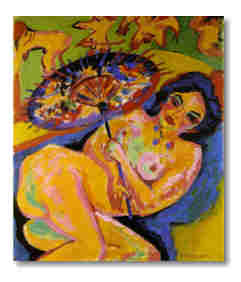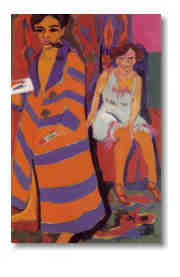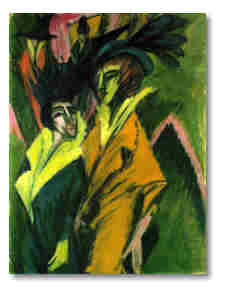



Kirchner was a twentieth-century artist who looked at non-Euopean
art with both an aesthetic eye and a spiritual eye. He endeavored
to redo it in European style, particularly the are of the Polynesian.
KIRCHNER'S THOUGHTS ON ART
"Years went by as I continued my
studio study, mostly drawings on the streets, in the city squares,
and in cafes. I attempted to translate these drawings into pictures.
Technically, I first used thick oil colors, then in order to cover
larger surfaces I applied the colors more thinly with a painting
knife, and then I used benzine (my secret for the mat finish)
with a wax additive. Every day I studied the nude, and movement
in the streets and in the of the naturalistic surface with all
its variations I wanted to derive the pictorially determined surface.
This is why I rejected academically correct drawing. Old masters
like Cranach and Beham supported me in this effort. When the simple
two-dimensional surface was purified I began shading the surface
in order to enrich the composition, first with black and
white, nowadays with other colors. At the same time I gained a
deeper understanding of human psychology by getting to know my
subjects better as human beings. I never had real models in the
academic sense. Of course, you have quite a bit of private information
about all this. Then, with insight into the limits of human interaction,
I undertook the withdrawal of the self from itself and its dissolution
within the other person's psyche for the sake of a more intense
expression. The less I was physically involved, something which
quickly occurred as a result of my mood, the more easily and completely
I entered into and depicted my subject. My technique kept pace
with this inner development until my induction into the army made
me afraid of people and revealed new things to me in landscape.
[19161
with black and
white, nowadays with other colors. At the same time I gained a
deeper understanding of human psychology by getting to know my
subjects better as human beings. I never had real models in the
academic sense. Of course, you have quite a bit of private information
about all this. Then, with insight into the limits of human interaction,
I undertook the withdrawal of the self from itself and its dissolution
within the other person's psyche for the sake of a more intense
expression. The less I was physically involved, something which
quickly occurred as a result of my mood, the more easily and completely
I entered into and depicted my subject. My technique kept pace
with this inner development until my induction into the army made
me afraid of people and revealed new things to me in landscape.
[19161
What you write about art, and creation
in general, is easy for me to under-stand. I also understand what
you mean about the artist and philosopher creating their own world.
Actually, such a world is only a means of making contact with
others in the  great
mystery which surrounds all of us. Thisgreat mystery which stands
behind all events and things (sometimes like a phantom) can be
seen or felt when we talk to a person or stand in a landscape
or when flowers or objects suddenly speak to us. We can never
represent it directly, we can only symbolize it in forms and words.
Think of it, a persons its across from us and we talk, and suddenly
there arises this intangible something which one could call mystery.
It gives to his features his innate personality and yet at the
same time it lifts those features beyond the personal. If I am
able to
great
mystery which surrounds all of us. Thisgreat mystery which stands
behind all events and things (sometimes like a phantom) can be
seen or felt when we talk to a person or stand in a landscape
or when flowers or objects suddenly speak to us. We can never
represent it directly, we can only symbolize it in forms and words.
Think of it, a persons its across from us and we talk, and suddenly
there arises this intangible something which one could call mystery.
It gives to his features his innate personality and yet at the
same time it lifts those features beyond the personal. If I am
able to join him in such a moment, I almost call it ecstasy,I can paint
his portrait. And yet this portrait, as close as it is to his
real self, is a paraphrase of the great mystery and, in the last
analysis, it does not represent a single personality but a part
of that spirituality or feeling which pervades the whole world.
join him in such a moment, I almost call it ecstasy,I can paint
his portrait. And yet this portrait, as close as it is to his
real self, is a paraphrase of the great mystery and, in the last
analysis, it does not represent a single personality but a part
of that spirituality or feeling which pervades the whole world.
I don't know whether I can express myself intelligibly. I can
only give you an example of what I understand by passivity. It
is the ability of so losing one's own individuality that one can
make this contact with others. It takes immense effort to achieve
this, yet it is achieved without willing it, to some extent unconsciously
without one's having to do with it. To create at this stage with
whatever means-words or colors or notes-is art." [1917]
INTRODUCTION WHAT ART IS SPIRIT OF ART REFLECTIONS BY ARTISTS MY WORKS OF ART